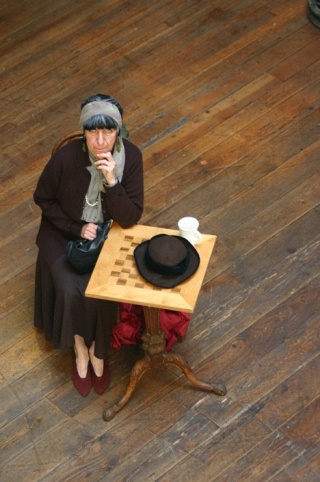Alice was a Victorian chain smoker with a slight mustache, gypsy earrings and manicured nails.
Alice who? Gertrude Stein’s widow, of course.
Alice B. Toklas was the other half of one of the most famous gay couples of the early 20th century.
She fell madly in love with the avant-garde writer Stein in 1907 after arriving from San Francisco, Calif. and becoming immersed in the art-soaked bohemian atmosphere of Paris, France where the other Bay area native Stein was already thoroughly ensconced.
There the two women would live at 27 Rue de Fleurus as American ex-pats for more than
30 years.
Actor Martha Furey takes the role of Toklas and plays out one of the most eccentric and dramatic love affairs of the era on stage at Whidbey Children’s Theater in “Gertrude Stein’s Widow, Alice B. Toklas” at 7:30 p.m. Oct. 24 to Oct. 26.
After meeting Stein for the first time, Toklas was intrigued.
“She was a golden brown presence, burned by the Tuscan sun and with a golden glint in her warm brown hair. She was dressed in a warm brown corduroy suit. She wore a large round coral brooch and when she talked, very little, or laughed, a good deal, I thought her voice came from this brooch. It was unlike anyone else’s voice — deep, full, velvety, like a great contralto’s; like two voices,” Toklas wrote later.
Alice Babette Toklas was born in San Francisco into an upper middle-class Jewish family. She was educated at public schools and at the University of Seattle and the University of Washington.
In 1908, Toklas began typing manuscripts for Stein and by 1909 she was part of her life.
“Gertrude was the one who attracted people,” Furey said.
“Once Alice became established as Stein’s partner, she was the one who would decide who would be eliminated or unwelcome.”
The couple famously held salons at their home for the many artists and writers who frequented Paris during the early part of the 20th century.
Stein would retire to the “inner sanctum” with friends such as Pablo Picasso, Henri Matisse and Ernest Hemingway, while Toklas entertained their wives and mistresses in another room.
As the couple became more established as partners, Toklas took a stand against certain celebrities who might seduce Stein.
In the play, Toklas says of Hemingway’s advances towards her lover: “I knew he would successfully conquer Gertrude and I would have to pick up the pieces.”
Thus Toklas became the manager of Stein in all ways, both in her business affairs and in her personal ones, making sure everyone knew that Stein was for her eyes only.
They were an extraordinary couple who were noted for their World War I wartime involvement with the American Fund for the French Wounded. The two volunteered to drive supplies to French hospitals in a converted Ford they named “Auntie” after Stein’s aunt Pauline, “who always behaved admirably in emergencies and behaved fairly well most times if she was flattered.”
An excellent cook and fond of paintings, furniture, tapestry, houses and gardening, Toklas life’s work was as the manager of Stein’s household and affairs. She devoted herself utterly to making Stein a success, acting as a background figure in the limelight of Stein’s glow. Toklas was often referred to simply as “Gertrude Stein’s girlfriend.”
Furey previously created other one-woman shows revealing the lives of memorable women such as Isadora Duncan, Freda Khalo and Georgia O’Keefe.
But unlike those singularly talented women, it was the strength of Toklas and Stein as a couple that inspired Furey to create “Gertrude Stein’s Widow.”
“I love the story of this love affair because they really became husband and wife,” Furey said.
“They were together for more than 30 years and the relationship never faltered.”
Stein died unexpectedly after a surgery for bowel cancer in 1946, 21 years before Toklas.
Toklas’ recipes were later recorded by her in “The Alice B. Toklas Cookbook,” her first book, published in 1954 when she was 77.
It contains 300 recipes of such dishes as “Artichokes Stravinsky,” “Bavarian Cream of Perfect Love” and “Green Peas á la Goodwife.”
The book became famous because one recipe, “Toklas’ Haschich Fudge,” submitted at the last minute by a friend, contains a mixture of fruit, nuts, spices and “cannabis sativa,” or marijuana. It was not printed in the first American edition, but was included in the British edition.
She inadvertently became associated with the famous recipe which she had, in fact, never tried.
Her name was later lent to a wide range of cannabis concoctions called Alice B. Toklas brownies.
But it was what she did for Gertrude Stein for which she wanted to be remembered.
Toklas cherished her memories of Stein and guarded her reputation.
In 1963, a generation after Stein authored “The Autobiography of Alice B. Toklas” which had practically nothing to say about Toklas and a whole lot to say about Gertrude Stein and gave Stein the fame she craved, Toklas published her own version of her life in “What Is Remembered.” She was 85.
In a final dramatic gesture, she converted from Judaism to Catholicism in her final years, having been told it would give her a ticket to the afterlife where she might be reunited with Stein in heaven.
Toklas died on March 7, 1967. She was buried beside Stein in Le Pere Lachaise Cemetery, Paris.
“Everyone has heard of Gertrude Stein but not Alice,” Furey said.
“Like her, I have a helpmate, my husband. He doesn’t give up his life for me completely like Alice did for Gertrude, but I appreciate his help so much. I appreciate what Alice did for love.”
“Gertrude Stein’s Widow” plays at 7:30 p.m. Friday, Oct. 24, Saturday, Oct. 25 and Sunday, Oct. 26 on the Martha Murphy Mainstage at Whidbey
Children’s Theater in Langley. Tickets cost $12.
Call 221-2282 for tickets and info.


